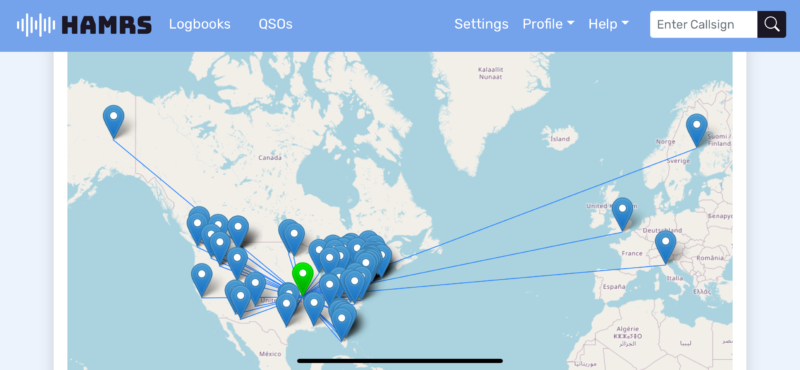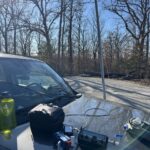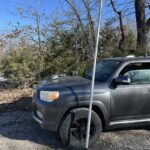
Wednesday morning I knew that I would have a hydraulic model running for several hours later in the day. After a couple of test runs, I started the first full run and sat at the computer for a few minutes, watching for an error/warning and listening to the fans run.
That was not going to do. So I looked at the POTA.app map to see what nearby parks I have not yet activated. I found a small conservation area (Niangua State Conservation Area, K-10214) about 45-minutes out and decided that would do. The sun had come out and I wanted to be outdoors.
I got The Girl ready and we walked out normal loop. I stuffed her into the rig while I went upstairs to retrieve my radio bag. Then we were off.
I called my buddy Dick on the way and we chatted about radio stuff until I got near where I thought I should exit the Interstate (dead reckoning). I pulled off the highway and looked at the map on my iPhone. My intuition was correct — I had exited on my turn instinctively.
So we drove the few short miles to the parking area, where I parked the rig and got out to survey. I decided to pull the rig forward a few feet and deploy the drive-on mast mount. I then retrieved the antenna bag from the back of the rig and the SOTAbeams 10m travel mast. I selected my end-fed half-wave antenna from the kit and the matching transformer.

Setup time was about 20-minutes, with some of that spent hunting the antenna bag in the back of the rig. Hmmmph…
I listened on the 10m band for a few minutes and checked the spots. One other activator was working 10m. So I decided to try. I picked a frequency, called QRL (is the frequency in use?), and listened. Nothing heard, so I punched the memory button and started calling while I spotted myself on the Internet.
After calling a few minutes there was no response. The 10m band was not open (for me). I listened for a couple of minutes on the 12m band and heard other stations operating, but every time I picked a frequency someone started calling.
“?#%@$# that” I thought, “I’ll just move to 15m.” So, I did.
I setup near the 21.060 QRP (low power) watering hole, listened, called QRL? again, and started calling while I respotted myself on the Internet.
In just a couple of minutes the callers started trickling in. What followed was about 1.75 hours of working stations. The 15m band provided a few contacts, then the 17m band filled out my quota. I worked both until I fished each hole dry.
Then I switched to the 20m band. I then spent the next hour working an almost steady pile-up of callers. About five minutes into the 20m band, my KX2 suddenly turned itself off. It would not restart.
“Battery died!” I thought. I dashed to the drivers side of my rig and grabbed the spare KX2 battery. I dashed back to the radio and plugged in the spare. I turned the radio back on and finished working my buddy Dick (he was the contact I was working when the battery died).
“K7ULM? BAT DIED” I sent. He repeated his exchange and I logged the contact.
I had noticed that the KX2 was only putting out about 5-6 watts although I had it set for 10 watts. The battery was running low and I did not realize it. Fortunately I had a ready spare and it took only a few seconds to grab it and be running again.
I was logging on my iPhone (HAMRS), which works for me when I am in the field. I saw a text message banner pass at the top of the screen. It was my buddy Dick who said “20m is not working very well today…”

The contact counter on my logging software said I had more than 65 contacts. I had worked through the pile-up, catching a fragment of a call or getting lucky when an operator called in the clear (between jumbles). My brain was pretty fried after working on the hydraulic model and then a number of big pile-ups.
I decided i had enough. The frequency was quiet — no callers. I sent DE AG7TX QRT SK (my call sign and I am signing off). Another caller appeared, so I worked that operator. (He was loud; it was an easy exchange.) I sent QRT again and turned off the radio.
I finished with 68 contacts in the log. I was the sixth activator of the park and the first code activator. Of course, there were lessons learned:
- The end-fed half-wave is a much better antenna than the AX1/AXE. Of course I knew that, but fast deployments have been a thing for me lately. I had the room for this activation and took advantage of a superior antenna.
- I thought the battery in the KX2 was in better shape. I thought that it was charging or at least not being used because I had used an external battery for the previous activations. I was wrong.
- The lesson is to always check battery state of charge before going to the field.
- Always have a spare battery handy. Things go bad.
- Working a big pile-up is part of the fun of radio. Park activations provide that opportunity. But it is hard brain work and requires focus.
- Expect to be tired after a park or summit activation. I was.
It was a good day. I chatted with Dick on my way home. I had 68 contacts in the log over an hour and three quarters. When I arrived home, Older Son was going through his workout. We went to supper after he finished and cleaned up.
I then showered and readied myself for bed. As I wrote, it was a good day. I am grateful. Life is good.
That which does not kill us, makes us stronger.
Heh heh… I should be a lot stronger. 😉
Nietzsche…